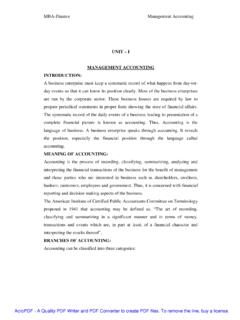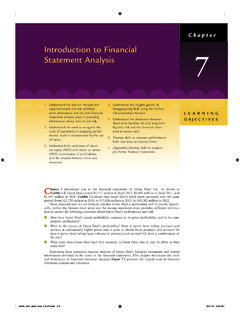Transcription of Chapter - 1 Risk Management: An Introduction
1 Chapter - 1 risk management : An Introduction A business has to try to minimise risks . But if its behaviour is governed by the attempt to escape risk, it will end up by taking the greatest and least rational risk of all: the risk of doing nothing. -Peter Drucker1 Introduction We live in a world of risk. Some risks are totally unexpected. The September 11, 2001 World Trade Centre attacks in the US, the Tsunami of December 2004, Hurricane Katrina of August 2005, and the Mumbai terrorist strikes of November 2008 are good examples. Other risks can be identified but the magnitude and extent are difficult to estimate. The sub prime crisis is a good example. Not all risks are so unpredictable or unexpected or difficult to estimate.
2 By closely monitoring the business environment and streamlining internal systems and processes, companies can anticipate the risks associated with changing technology, changing customer tastes, changing interest and currency rates, changing competitive conditions, etc. This book provides a conceptual framework for dealing with some of these risks in a systematic and coordinated way across an organization. To keep the scope of the book manageable, the focus will be on financial risks . Other risks will be considered in passing. Major upheavals in recent years 1971 : Breakdown of Bretton Woods 1973 : Oil shock 1987 : US Stock market crash 1989 : Crash of the Nikkei Index 1994 : Mexican Peso crisis 1997 : Asian currency crisis 1998 : Russian rouble crisis/collapse of LTCM 2000 : Dotcom bust 2001 : WTC terrorist attack 2007 : Sub Prime Crisis 2008 : Collapse of Bear Stearns, Lehman, AIG, Understanding risk management Risk management has returned to the top of the agenda in the wake of the sub prime meltdown.
3 Lehman Brothers, Bear Stearns and Merrill Lynch no longer exist. The US government has acquired a major equity stake in Citibank, while the UK government has done so in the case of Royal Bank of Scotland. Many European banks are in trouble and might well have collapsed but for government intervention. For all practical purposes, much of the British banking system has been nationalized. In a few days during October 1 Managing for Results 2 2 2008, the entire banking system in Iceland collapsed and was taken into public ownership. The country s average income fell from 160% of that of the US in 2007 to 80% by 2009. And as the credit crisis has spread from banking to other sectors, we have seen corporates also getting sucked into the whirlpool.
4 The American automotive giants, General Motors (GM), Ford and Chrysler are in big trouble. President Barrack Obama has announced comprehensive bail out plans for GM and Chrysler. Companies like Toyota and Sony have declared losses for the first time in several years. Toyota the Japanese car manufacturer, with an impressive track record of revenue and profitability growth over the years, announced in the last week of August 2009 that it would slash worldwide production. Quite clearly, risk management systems failed to deliver the goods during the recent crisis. And the price paid by the global economy has been heavy. It is evident that financial institutions and companies need to develop and apply a far more robust and integrated risk management framework that can inspire the confidence of shareholders.
5 From identifying risk to measuring it and controlling it, the entire risk management process will have to undergo a major overhaul in the coming years. To start with, top management will have to be hands on when it comes to understanding and managing risk. This is not a new concern. As the Economist2 once put it: Top managers often fail to understand properly the firm s sensitiveness to different types of managers and boards too often regard risk management as a matter for financial experts in the corporate treasury department rather than as an integral part of corporate strategy. But recent incidents such as the collapse of Bear Stearns where CEO Jimmy Cayne was enthusiastically taking part in bridge tournaments while the bank was collapsing, have reinforced this concern.
6 Similarly, the Swiss bank, UBS had admitted on its website that its top management should have asked more probing questions when the bank s traders were building huge positions in sub prime mortgages. Another concern is the way in which companies deal with different risks in a piecemeal fashion. For example, many banks dealt with credit and market risk separately in the build up to the sub prime crisis. The credit risk in case of many sub prime assets became market risk as market indices moved, leading to heavy mark-to-market losses. An organization wide view of risk management can greatly improve efficiencies, generate synergies and most importantly result in a deeper understanding of risk exposure.
7 Which is why banks like UBS have now started to integrate the management of credit risk and market risk. That is also why many companies are taking a serious look at Enterprise Risk management (ERM), which addresses some fundamental questions: What are the various risks faced by the company? What is the magnitude of each of these risks ? What is the frequency of each of these risks ? What is the relationship between the different risks ? How can the risks be managed to maximize shareholders wealth? 2 February 10, 1996. 3 3 We will examine the theme of integrated risk management in more detail in a later Chapter . Risk identification at Pitney Bowes While risk management is critical for financial institutions, corporates too are realizing the importance of risk management .
8 Pitney Bowes, the postal machine maker is a good example. In recent years, this company has started to take risk management very seriously. The company s enterprise risk management system identifies and prioritizes potential risks to the business financial , environmental and societal. These risks are assessed in terms of probability, severity and status of mitigation plans. Sixteen categories of risk have been identified. The risks identified are reviewed by a senior management Risk Steering Committee and the Board of Directors. Each risk is assigned to a senior executive. The firm has taken the view that risk management is a philosophy, not merely numbers. As a senior executive mentions3, We have a much more holistic discussion about a business and why we have it.
9 It becomes strategic, instead of simply, do we get insurance to cover a potential loss? The benefits of risk management What is the rationale for risk management ? Does risk management really benefit the shareholders? After all many of the risks a company faces, are specific to it. Portfolio theory argues that shareholders are rewarded only for systematic risk. Unsystematic risk, , risk specific to a company can be diversified away by purchasing shares in a reasonably large number of companies. If shareholders can manage risk more efficienty on their own, by buying shares in various corporations, should companies really manage risk? The answer is an emphatic yes. How Risk management adds value Enterprise Risk management creates value at both a macro or company-wide level and a micro or business-unit level.
10 At the macro level, ERM creates value by enabling senior management to quantify and manage the risk-return tradeoff that faces the entire firm. At the micro level, ERM becomes a way of life for managers and employees at all levels of the company. Incorporating risk in decision making ensures optimal use of capital. Source: Brian Nocco, Rene Stultz, Enterprise Risk management : Theory & Practice4. For starters, shareholders do not have all the information needed to manage the risks a company faces. Moreover, even if they had, individual shareholders would find it inefficient and expensive to manage risks on their own. The transaction costs would be too high if a large number of small hedging transactions are undertaken.











